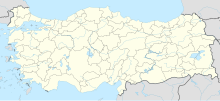Adana Archeological Museum
| Adana Arkeoloji Müzesi | |

A statue from Tel Halaf at the Museum
|
|
| Established | 1924 |
|---|---|
| Location | Fuzuli Street, Adana, Turkey |
| Coordinates | 36°59′30″N 35°19′53″E / 36.991667°N 35.331389°E |
| Type | Archeological |
| Area | 588,000 sq ft (54,600 m2) in 94 Galleries |
Adana Archaeology Museum, (Turkish: Adana Arkeoloji Müzesi), located just west of the Sabancı Mosque in Adana, houses the historical heritage of Çukurova region. It is one of the oldest ten museums of Turkey.
The museum was established at the Police Department building just after the formation of the Republic in 1924. It initially started with the collection of the columns, column capitals and sarcophagi found in the vicinity of the building. Alyanakzade Halil Kamil Bey from Adana was appointed as the museum director and with his successful work, the accumulated material was moved in 1928 to the madrasah section of the no longer existing Cafer Pasha Mosque and then opened to the public.
The museum was moved to the building presently occupied by the Ethnography Museum at Kuruköprü in 1950. Material from the early ages of Çukurova which was discovered during the excavations carried out at Tarsus/Gözlükule (1934), Mersin/Yumuktepe (1936), Ceyhan/Sirkeli (1938) and Yüreğir/Misis(1958) in particular, was collected at the museum. The museum eventually was filled to the brim with the ethnographic material collected by the museum director Ali Rıza Yalman (Yalkın) during the investigations he carried out between 1933 – 1940, and as it was the only museum of the region with material obtained either through purchases or court decisions from a large area reaching from Kahramanmaraş to Gaziantep, the museum moved to its current premises on January 7, 1972.
At the museum entrance, there is a gate lion from the Hittite period and two Augustus statues from Silifke/Taşucu and Uzuncaburç. The exhibited material includes sarcophagi with rich garland decorations, jugs, catapult shots, inscriptions, altars and various architectural elements.
...
Wikipedia

